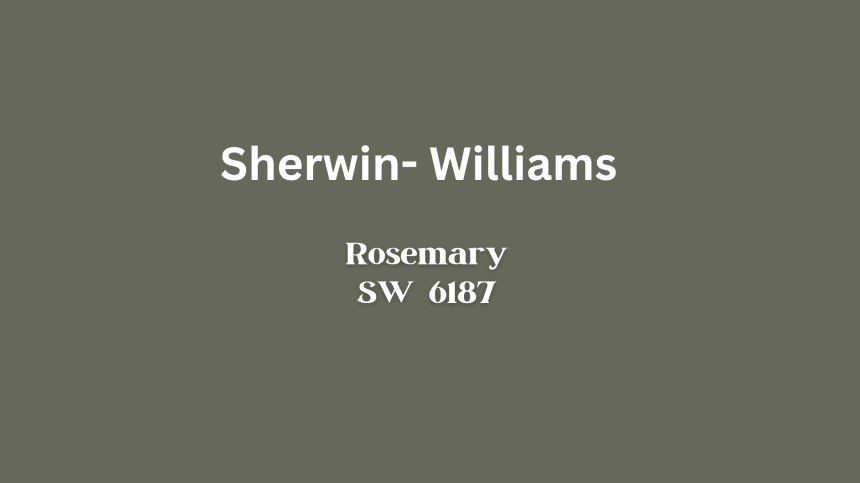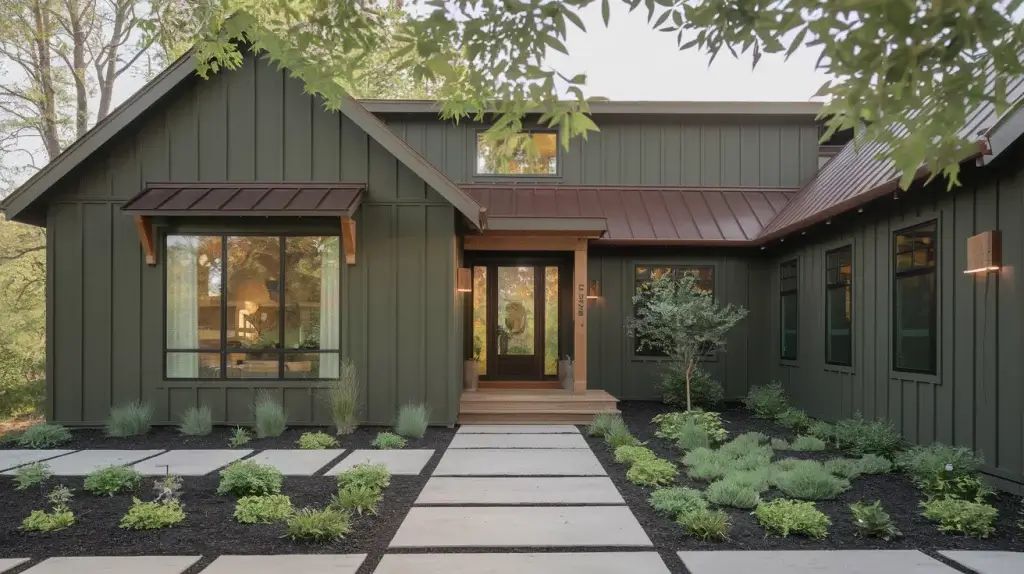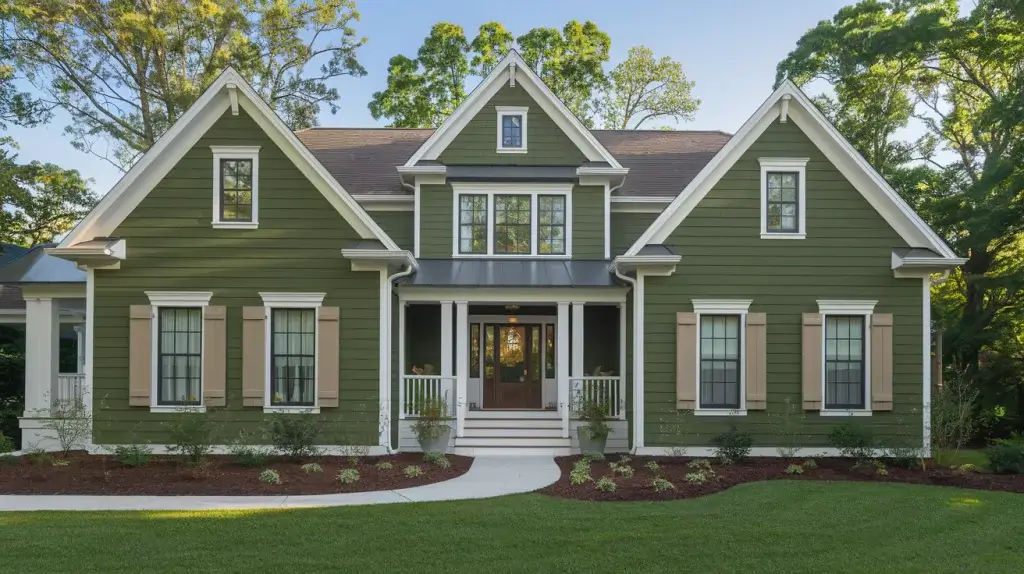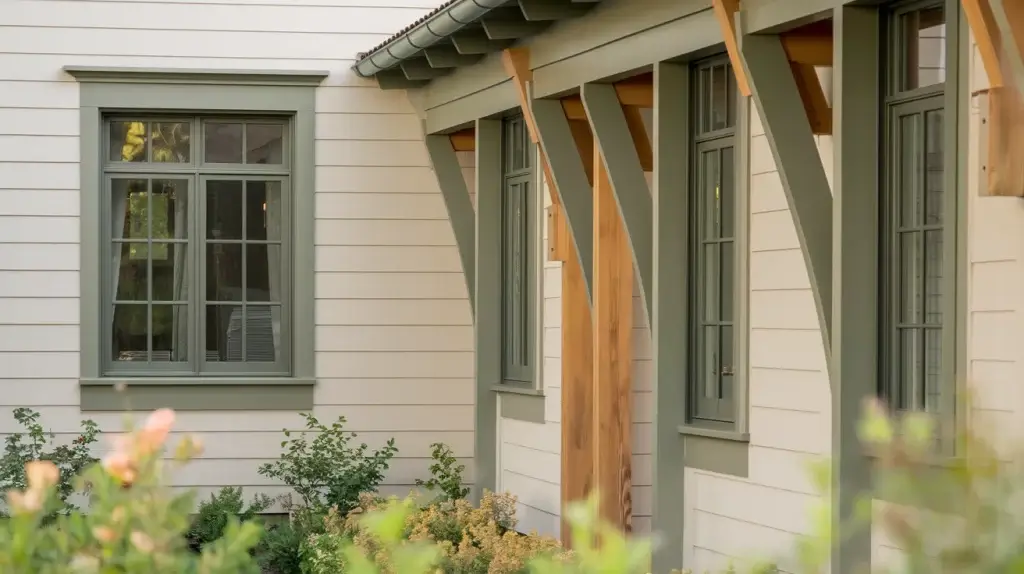Are you looking for the perfect green paint for your home’s exterior? Many homeowners feel stuck when choosing between countless shades of green.
What makes Sherwin Williams Rosemary different is its balanced mix of sage and forest green tones that work in both sunny and shaded areas.
This versatile shade can make your home stand out while still fitting naturally into the neighborhood. Plus, it pairs beautifully with white trim, wooden accents, and stone features.
Are you ready to see if Sherwin Williams Rosemary is right for your home?
Let’s examine what makes this color a smart choice for your exterior paint project.
Understanding Sherwin Williams Rosemary
Sherwin Williams Rosemary (SW 6187) is a deep, muted green with soft gray undertones, creating a balanced and natural look.
Rosemary is a timeless and elegant green that adapts beautifully to different lighting conditions.
Whether in natural light or dim interiors, it remains a sophisticated, nature-inspired choice for both interiors and exteriors.
Color Characteristics
- Hue: A rich, earthy green with a hint of gray, making it sophisticated and adaptable.
- LRV (14): Absorbs more light than it reflects, giving it a moody and deep appearance.
- Undertones: There is no strong yellow or blue, keeping it a true neutral green. Soft gray undertones add depth, making it refined and calming.
How Lighting Affects Rosemary
1. Direct Sunlight
- In bright natural light, Rosemary appears lighter and fresher.
- The green looks more vibrant but still maintains its muted tone.
- Works well on exteriors with a lot of natural light exposure.
2. Overcast or Shaded Areas
- In low-light conditions, Rosemary looks deeper and moodier.
- The gray undertones become more noticeable, making the color feel richer.
- In shaded spaces, it can appear almost forest green, creating a cozy and intimate feel.
3. Artificial Lighting
- Under warm indoor lighting, Rosemary looks soft and inviting, with its green tones standing out.
- In cooler artificial light, the gray undertones become more dominant, making it appear more muted.
- Perfect for spaces that want a balance between earthy warmth and modern sophistication.
Why Choose Sherwin Williams Rosemary for Your Home’s Exterior?
A Perfect Fit for Any Home Style
Whether your house is a classic design from decades past or built in a modern style, Rosemary brings out the best in your architecture.
This green shade feels at home on any house, from simple country homes to city dwellings.
Its natural color makes your house stand out while still looking like it belongs in the neighborhood.
Making Your Home Stand Out
While many homeowners stick to safe whites and grays, Rosemary offers something different. This green shade makes a lasting impression without being too bold.
It’s the kind of color that makes people slow down as they pass by, taking a second look at your home’s beauty.
Works Well with Other Materials One of Rosemary’s best features is how it pairs with different building materials:
- Brings warmth to light-colored stone
- Adds depth next to red brick
- Creates a beautiful contrast with natural wood
- Makes the white trim look crisp and clean
Natural Fit with Your Landscape
Your garden and lawn will look even better next to Rosemary-painted walls. The color complements the natural greens in your landscaping while adding subtle charm.
It creates a smooth transition between your home and its surroundings, making everything look well-planned and put together.
Best Applications of Rosemary on Exteriors
Sherwin Williams Rosemary (SW 6187) is a deep, muted green that looks beautiful in various exterior applications.
Whether used as the main color or in smaller details, it brings a timeless, cultured, and natural touch to any home.
1. Full Exterior Paint
Best for: Large homes or those wanting a bold, modern look.
Painting the entire exterior of Rosemary gives a home depth and character while maintaining a connection to nature.
Since it’s a rich, darker green, it works best when paired with light trims and contrasting accents.
Homes with brick, stone, or wood elements benefit from its organic feel, creating a harmonious and balanced exterior.
Pair with:
- Trim: Off-whites like Sherwin Williams Alabaster (SW 7008) for a crisp contrast.
- Roofing: Dark gray or charcoal shingles to enhance its moody elegance.
- Landscaping: Soft green plants and warm-toned flowers for a natural flow.
2. Front Doors & Shutters
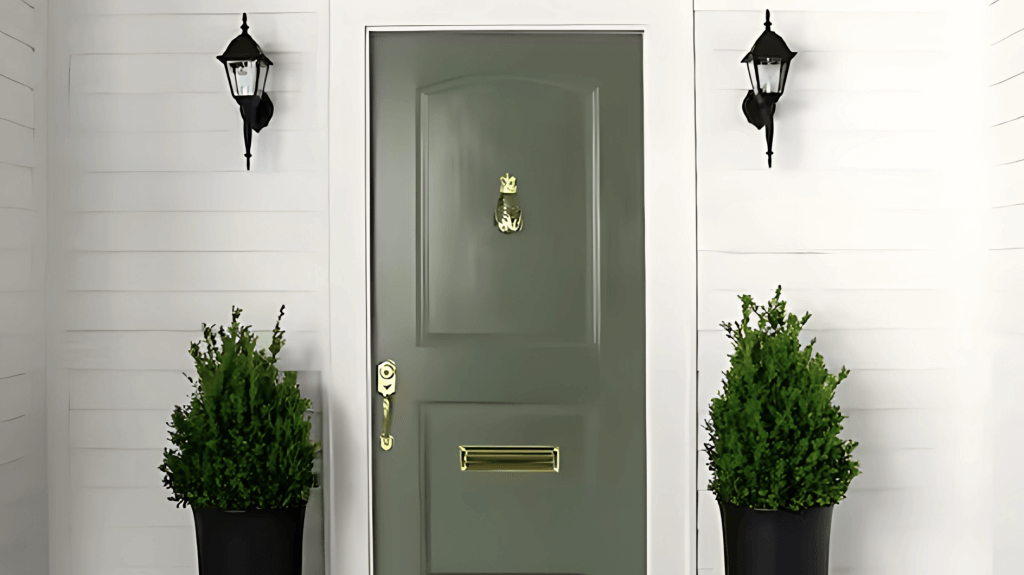
Best for: Creating a welcoming and stylish entrance.
A Rosemary-painted front door adds a sophisticated yet inviting touch to a home’s exterior.
It stands out without being too overpowering, making it an excellent choice for those who want a bold yet timeless entryway.
Rosemary shutters provide a subtle contrast against lighter walls, adding depth without overwhelming the façade.
Pair with:
- Main exterior colors: White, beige, or light gray to let the door pop.
- Hardware finishes: Brass or matte black for a modern touch.
- Porch accents: Natural wood planters and warm lighting for a cozy feel.
3. Garage Doors & Fencing
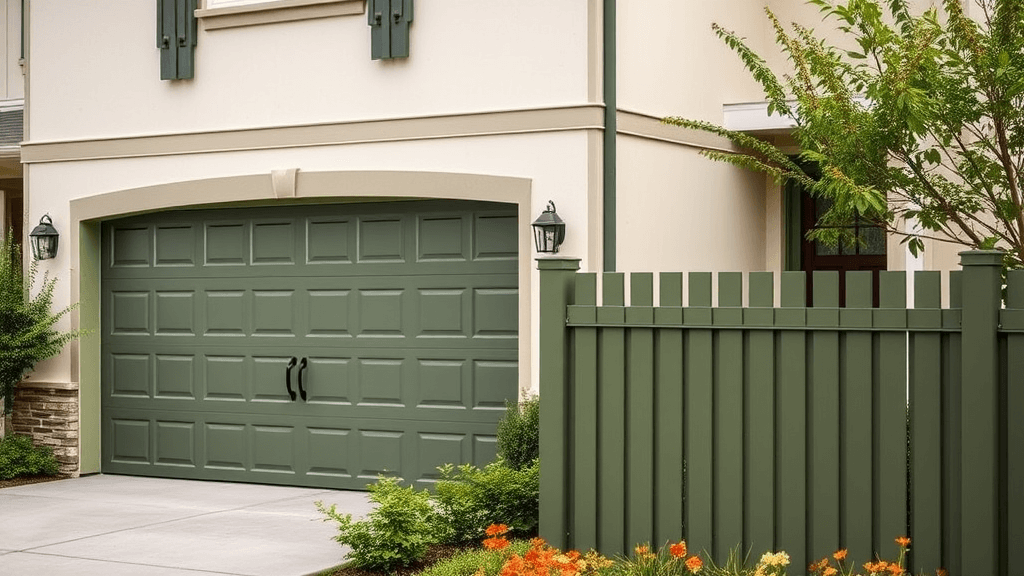
Best for: Adding depth and a unique character to the home’s exterior.
Using Rosemary on garage doors and fences creates a polished and well-coordinated exterior.
Since these elements often take up a large visual space, Rosemary provides a stylish alternative to traditional neutrals.
It complements stone driveways, wooden gates, and lush greenery, giving homes a natural, timeless charm.
Pair with:
- Trim & accents: Black or dark bronze for a modern, sleek look.
- Driveway materials: Stone or textured concrete for an elegant contrast.
- Fence material: Works well with both wooden and metal fences.
4. Window Trims & Beams
Best for: Adding subtle contrast and natural warmth.
Painting window trims and beams in Rosemary provides a refined and cohesive look without overwhelming the entire exterior.
It frames windows beautifully and adds an earthy richness to the home.
Beams in Rosemary can blend with natural wood textures, making the architectural elements feel more connected to the environment.
Pair with:
- Main exterior colors: Light neutrals like Sherwin Williams Snowbound (SW 7004).
- Roof and accents: Wood shingles or natural stone for a rustic appeal.
- Outdoor furniture: Warm brown or cream-colored seating for a coordinated look.
5. Porch Ceilings & Overhangs
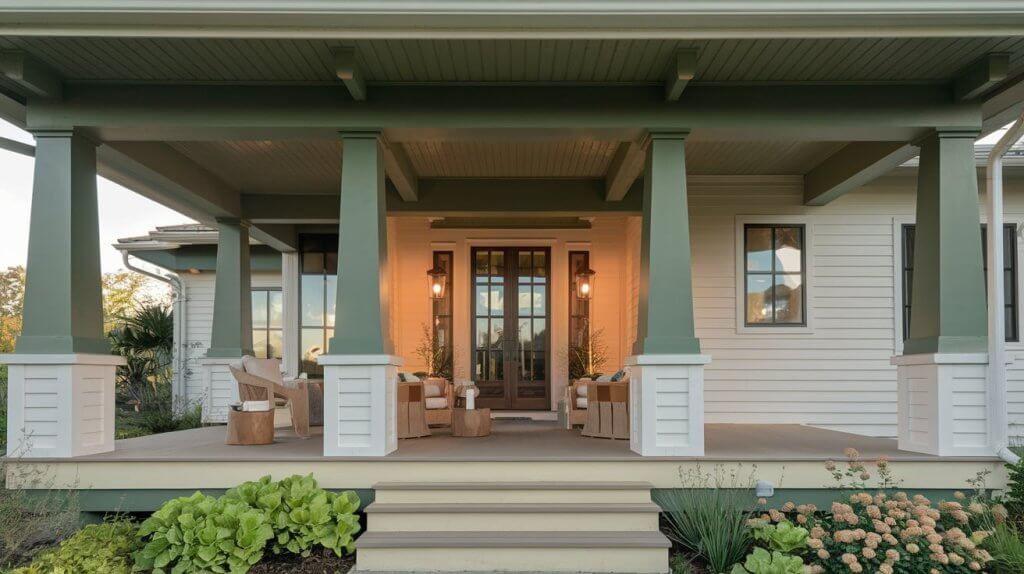
Best for: A unique, cozy ambiance.
Painting porch ceilings and overhangs in Rosemary creates an unexpected yet inviting charm.
This technique works especially well for homes with covered porches or wrap-around verandas, as it adds depth without overwhelming the space.
The soft green tone is calming and refreshing, making the porch area more relaxing.
Pair with:
- Main exterior walls: Soft grays, whites, or taupes for a balanced contrast.
- Outdoor lighting: Warm brass sconces or vintage lanterns for an elegant touch.
- Porch furniture: Wicker chairs and neutral-toned cushions for a cozy look.
6. Outdoor Furniture & Decor
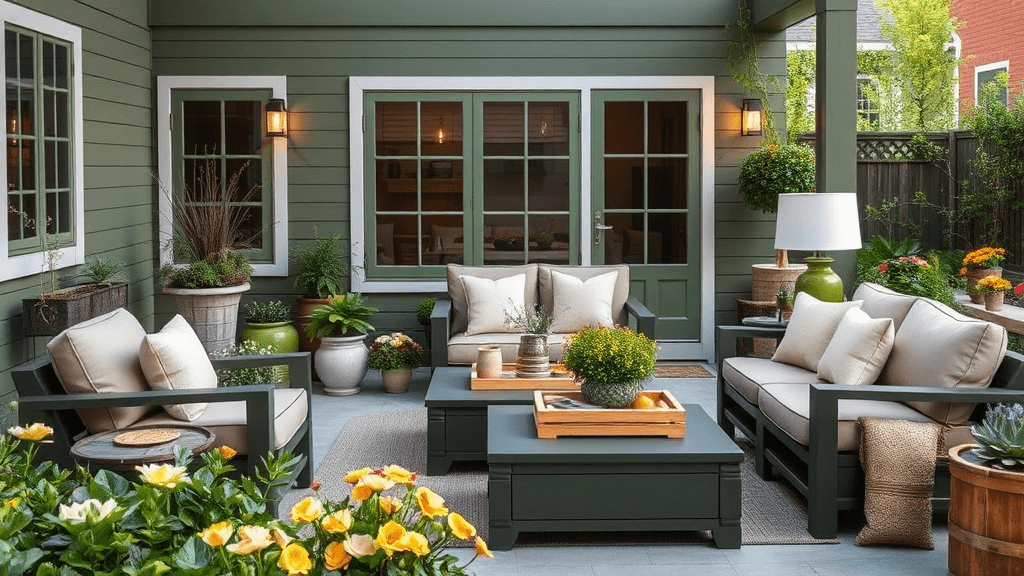
Best for: Coordinating exterior elements for a cohesive look.
Using Rosemary on benches, pergolas, planters, or patio furniture brings a subtle but intentional design element to outdoor spaces.
When repeated in different exterior accents, it helps create a harmonious and well-thought-out aesthetic.
Pair with:
- Materials: Wood, metal, or stone for natural contrast.
- Cushions & decor: Earthy tones like beige, rust, or soft blues.
- Lighting: Soft white or warm yellow bulbs for a cozy ambiance.
Comparing Rosemary to Other Green Shades
Rosemary vs. Evergreen Fog (SW 9130)
Think of Evergreen Fog as Rosemary’s lighter cousin. While both colors work well on homes, they create different effects:
- Evergreen Fog feels softer and more subtle, like morning mist in a garden
- Rosemary shows up stronger and warmer, making a clearer statement
- If you want a gentle green, go with Evergreen Fog
- Choose Rosemary when you want your color choice to be noticed
Rosemary vs. Pewter Green (SW 6208)
These two colors might look similar at first glance, but they have key differences:
- Pewter Green leans into its gray side, creating a cooler feel
- Rosemary stays true to its green nature with a natural, balanced look
- Pewter Green works better in modern designs
- Rosemary fits naturally in both modern and traditional settings
Rosemary vs. Ripe Olive (SW 6209)
Here’s where we see the biggest contrast:
- Ripe Olive is much darker, almost reaching black in some lights
- Rosemary keeps its green identity clear in any lighting
- Ripe Olive makes a strong, dramatic statement
- Rosemary offers a more versatile, livable green that’s easier to work with
Understanding these differences helps you pick the right green for your home.
While all these colors have their place, Rosemary strikes a balance between making a statement and being practical for everyday living.
Before You Paint: Crucial Things to Keep in Mind
Always test Rosemary at home before committing. Get peel-and-stick samples and place them on each side of your house.
Watch the color in different lights – morning, noon, and evening. This step helps you avoid surprises after painting.
Keep in mind that Rosemary might not work best.
Think twice about using it on heavily shaded walls or homes surrounded by thick greenery, as the color might look too dark or blend in too much with your landscape.
For best results, choose a satin finish instead of a matte one. Satin stands up better to weather and makes cleaning easier.
Plan to wash your walls gently once a year and touch up any spots that show wear. These simple steps will help your paint job last longer and look better.
Conclusion
Sherwin Williams Rosemary brings a perfect balance of boldness and subtlety to home exteriors.
Its deep green shade with gray undertones works equally well as a full house color or elegant accent.
By bridging the gap between traditional neutrals and statement colors, Rosemary creates curb appeal that feels both fresh and timeless.
This versatile shade proves that going green doesn’t mean going too bold.

